Moss and Fungus as Survival Resources: Ultimate Guide
Discover how I leverage Moss and Fungus as Survival Resources in the Canadian wilderness. Learn identification, preparation, and uses for emergency sustenance and medicine
SURVIVAL POSTS
Kathrine-Anne Hill
11/8/202413 min read
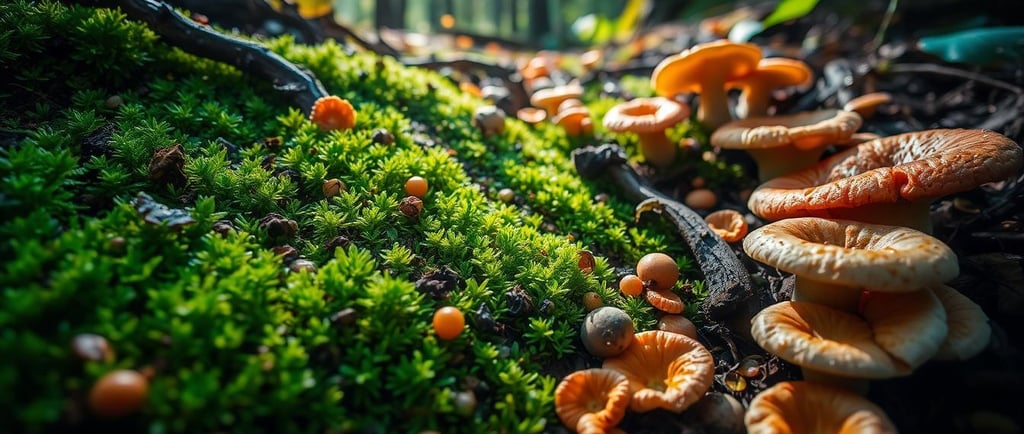

Affiliate Disclosure:
Please note that some of the links in this article are affiliate links. This means that if you click on these links and make a purchase, I may receive a small commission at no additional cost to you. This commission helps support the maintenance and growth of this website and allows me to continue providing valuable information and recommendations. Rest assured, I only recommend products and services that I have personally used or thoroughly researched. Your support is greatly appreciated! “As an Amazon Associate I earn from qualifying purchases.” For full disclosure see our Privacy Policy and Terms and Conditions here.
Moss and Fungus as Survival Resources | Ultimate Guide
Have you ever wondered how our ancestors survived in the wilderness without modern tools? The answer might be right under your feet. Moss and fungus, nature's hidden treasures, have supported life for millions of years.
In the Canadian wilderness, these organisms are more than just decorations. They are essential survival tools, providing food and medicine. As someone who loves foraging and wilderness survival, I've learned how adaptable moss and fungus are in tough environments.
From British Columbia's rainforests to Nunavut's tundra, these wild edibles are key in ecosystems. Did you know plants first came from water 500 million years ago with fungi's help? Or that there are about 3.8 million fungal species worldwide, with 90% unknown?
In this guide, we'll explore the world of moss and fungus. I'll share tips on how to identify, prepare, and use these survival powerhouses. Whether you're going off-grid or just want to learn more about foraging, this guide will help you with essential wilderness survival skills.
Key Takeaways
Moss and fungus are vital survival resources in Canadian wilderness
These organisms offer both nutritional and medicinal benefits
Proper identification is key to safe foraging of wild edibles
Moss and fungus play vital roles in ecosystem health
Learning about these resources enhances wilderness survival skills
Understanding Nature's Hidden Treasures
I've always been fascinated by nature's hidden treasures. As an outdoor enthusiast, I've learned that moss and fungi are incredible natural resources for survival. These organisms play a key role in our ecosystem and have been used by humans for centuries.
Basic Biology and Classification
Moss and fungi are eukaryotes, multicellular organisms with a nucleus. Mosses thrive in wet environments as non-vascular plants. Fungi, on the other hand, emerged from the sea over 2 billion years ago. Their unique biology makes them essential for outdoor preparedness.
The Role in Ecosystem Survival
These organisms are vital for ecosystem survival. Fungi form symbiotic relationships with plants, providing essential nutrients. The mycelium network stretches for kilometers, facilitating nutrient exchange and communication among plants. This is nature's bounty at work.
Historical Uses Throughout Human History
Throughout history, humans have harnessed these natural resources for various purposes. From food and medicine to ecological indicators, moss and fungi have been integral to human survival. In my outdoor adventures, I've learned to appreciate their historical significance and practical applications in wilderness survival.
"In nature, nothing is perfect and everything is perfect. Trees can be contorted, bent in weird ways, and they're yet beautiful." - Alice Walker
Moss and Fungus as Survival Resources
In my journey to learn wilderness survival skills, I discovered the value of moss and fungi. They are nature's secret treasures for living off the grid and finding food in the wild. Mosses have been around for 450 million years, thriving in many places, which makes them key for survival.
Mosses can soak up a lot of water and keep the soil moist. This is very useful for finding clean water in the wild. Some mosses can even make food in temperatures from -15°C to 40°C, showing how tough they are.
Fungi are also very useful for survival. Did you know 80% of plants work with fungi to grow better? This teamwork is also helpful in survival, where fungi can be eaten or used to start fires.
Mosses for insulation and first aid
Fungi as food and fire-starting material
Both organisms for water retention and soil stabilization
Moss and fungi are everywhere, making them great survival tools. By learning to identify them and what they can do, I've improved my survival skills. They not only help us survive but also teach us about the complex life in our ecosystems.
Essential Identification Skills for Foragers
Learning to identify mushrooms is key for safe foraging. It's important to know which mushrooms are safe to eat and which ones to avoid. Here are some essential skills for every forager.
Common Edible Species Recognition
Chanterelles are one of my favorite mushrooms to forage. They are known for their unique taste and health benefits. They are full of vitamins C and D, and potassium.
I look for their bright yellow color, wavy edges, and a fruity smell when I'm foraging.
Dangerous Look-alikes to Avoid
Not all mushrooms are safe to eat. False chanterelles, for example, look a lot like true chanterelles but can be harmful. To stay safe, I check for a few key differences.
Color: False chanterelles are more orange or reddish
Gills: They have straighter gills than true chanterelles
Aroma: They don't have the fruity smell of true chanterelles
Seasonal Availability Patterns
Knowing when mushrooms grow is important for successful foraging. True chanterelles grow in damp areas under hardwood trees. False chanterelles prefer coniferous woods.
It's important to know the best times to forage. I always check local guides for the best seasons.
Nutritional Value and Medicinal Properties
Moss and fungi are great for survival food. In my survival training, I learned about their benefits. They can be lifesavers in emergencies.
In eastern Bosnia, people used mushrooms and lichens to survive a siege. They ate 25 mushroom species and 7 lichen species. The most popular mushrooms were Agaricus campestris, Boletus edulis, and Cantharellus cibarius. These fungi gave them essential proteins, minerals, and fats.
Lichens like Evernia prunastri and Usnea sp. were used in porridge and flour. At first, people were scared. But these natural foods proved valuable for nutrition and health.
The world is now focusing more on fungi as food. In 2019, mushroom cultivation hit 11.9 million tons globally. Companies are making meat alternatives with fungi, seeing their nutritional value. As I learn survival skills, I'm amazed by these natural wonders.
Harvesting Techniques and Sustainable Practices
In my survival training, I learned to harvest moss and fungus sustainably. It's all about the right tools, timing, and care for the environment.
Tools and Equipment Needed
For foraging, I always bring these essentials:
A sharp knife for clean cuts
Collection bags to keep samples separate
A reliable field guide for identification
Gloves to protect hands and the environment
A couple of great resources are Samuel Thayer's "The Forager's Harvest" and John Kallas "Edible Wild Plants", For a really good foraging kit the VylerSky Foraging Kit comes with a mesh bag and a knife with a brush.
Best Time for Collection
Collection times vary by species. For moss, I harvest in early spring or late fall when it's moist. Fungi are best gathered in late summer to early fall after rains.
Conservation Guidelines
To protect these resources, I follow these guidelines:
Take only what I need
Avoid rare or endangered species
Minimize habitat disturbance
Leave at least 2/3 of a patch untouched
By using these techniques, I help ensure my foraging doesn't harm nature. It's all about survival skills and preserving the wilderness.
Processing and Preservation Methods
Learning to process and preserve moss and fungi is essential for off-grid living. These steps keep the nutrients in these foods, making them a steady source of nutrition.
Cleaning and Preparation
When I forage, I first clean my finds. I remove dirt, bugs, and other debris. For mushrooms, I gently brush them. Moss gets a good rinse in clean water.
Drying Techniques
Drying is my favorite way to keep moss and fungi fresh. I lay them out on screens or hang them. Sun drying works in dry places, but I use a dehydrator for better results. Low heat helps keep nutrients in.
Storage Solutions
After drying, I put them in airtight containers. Glass jars with tight lids are perfect. For long storage, I grind mushrooms into powder. This saves space and makes them easy to add to meals.
By learning these methods, I've improved my off-grid living and wilderness survival skills. These techniques make sure I always have a reliable food source from nature.
Survival Applications in Wilderness
I've learned that wilderness survival skills are more than just modern gear. Nature has amazing resources that can greatly help us stay safe outdoors. Moss and fungi, often ignored, are key survival tools.
In my bushcraft adventures, I found that moss is more than just a fuzzy ground cover. It's a survival superstar. I use it as a natural compass to find direction. It also keeps me warm in cold conditions by insulating my shelters.
Fungi are also very useful. I've used them to start fires, thanks to their dry, fibrous structure. This makes starting a fire easy, even when it's wet. Some fungi also help with injuries, acting as a natural first aid kit.
Moss is also great for purifying water. I've used certain moss species to filter out impurities. This has been a lifesaver when clean water was hard to find.
Learning these wilderness survival skills has made me better prepared for the outdoors. Knowing that nature provides tools like moss and fungi makes me less reliant on modern supplies. It also deepens my connection with the wilderness.
Moss Species for Water Filtration
In wilderness survival, moss is a key natural resource. It has water filtering properties that are very useful in survival situations.
Natural Filtering Properties
Moss has been around for millions of years. It has evolved to absorb pollutants and excess nutrients from water. This makes it great for improving water quality in wetlands.
For example, Sphagnum moss can remove contaminants and lower bacterial levels in water.
Implementation Methods
To use moss for water filtration, I set up layered systems or fill containers with moss. It's not a complete solution, but it makes water better. Here's how to do it:
Collect clean moss, preferably Sphagnum
Rinse the moss to remove debris
Place moss in a container with small holes at the bottom
Pour water through the moss layer
Collect filtered water in a clean container
Remember, moss filtration doesn't make water safe to drink. Always use extra purification methods for safe drinking water in the wild.
Fungal Resources for Fire Starting
In my journey of learning wilderness survival skills, I found out how great fungi are for starting fires. These often-overlooked organisms are key to being ready for the outdoors, even when it's tough.
Some bracket fungi, like the horse's hoof fungus, make a special material called amadou. This stuff is amazing for starting fires. It can catch a spark and light up, even when it's wet. This makes it super useful for staying alive when things get tough.
It's cool that some fungi actually like fire. These "fire-loving" fungi show up after fires. A study in the Great Smoky Mountains National Park found their DNA in mosses, lichens, and soil. This shows they can survive fires and come back when there's another one.
To use fungi for starting fires:
Find the right bracket fungi
Harvest them carefully to not harm the environment
Make amadou from the fungus
Keep it in your survival kit
By learning about and using these natural fire starters, we can get better at surviving outdoors. Nature has a lot to offer if we just know where to look!
Traditional Knowledge and Modern Science
Indigenous wisdom and science are joining forces. This blend is changing how we learn about nature and survival. It's making foraging and wilderness survival better.
Indigenous Wisdom
Traditional knowledge is key for Indigenous survival skills. The Cree teach us to respect nature. They ask permission before crossing creeks and pray when interacting with the environment.
"We treat Mother Earth with respect," says Cree Elder Clifford Cardinal, highlighting the sacred bond between Indigenous communities and the land.
This connection to nature helps us forage sustainably. It teaches us how to use natural resources wisely.
Scientific Research Findings
Modern science is proving many traditional practices right. Ecologist Suzanne Simard's work on forest networks matches Indigenous knowledge. Her research shows how trees talk to each other through fungi, something Indigenous cultures have known for a long time.
Combining traditional wisdom with science is changing survival skills. It's improving foraging and making us appreciate nature's complexity more.
By using both traditional wisdom and science, I can better understand and respect nature.
Environmental Indicators and Air Quality
I've found that nature's hidden treasures, like lichens and mosses, are key for outdoor preparedness. These tiny organisms are like silent sentinels, showing us the health of our environment.
In my wilderness survival skills training, I've learned to read these natural indicators. Lichens, for example, grow very slowly, about 0.5 to 5 mm a year. Their slow growth makes them great air quality monitors.
When I explore, I see that poor air quality areas have only crusty lichens like Lecanora conizaeoides. But areas with cleaner air have leafy lichens like Parmelia caperata. Knowing this helps me choose safer campsites or water sources.
Mosses also help in this natural early warning system. I find them in damp, shaded spots in many ecosystems. Studies show they're very sensitive to cadmium pollution, helping me assess the environment better.
Learning about these natural indicators helps me prepare better for the outdoors. It shows that in nature, every organism has a story to tell. We just need to learn how to listen.
Safety Considerations and Precautions
As I explore foraging and wilderness survival, I've learned safety is key. Using moss and fungi for outdoor preparedness requires careful attention. Let's look at some important points to remember.
Risk Assessment
My foraging starts with a detailed risk assessment. I make sure to identify plants correctly and understand their toxicity. I also consider my health. For example, some fungi can cause serious reactions, so I only eat what I'm absolutely sure is safe.
Emergency Response
I have emergency plans for accidents or bad reactions. I carry a first-aid kit and know the signs of poisoning. Did you know fungal infections can happen from touching contaminated plants? It's vital to clean cuts and scratches right after foraging.
Legal Considerations
I always check local laws before I forage. Some places have strict rules about taking plants and fungi. For example, in some Canadian provinces, there are limits on how much you can gather.
It's not just to avoid fines. It's about keeping nature safe for others and protecting our ecosystems.
Outdoor preparedness is more than just knowing what to use. It's about using that knowledge wisely and safely. By following these tips, I make sure my wilderness survival skills improve my outdoor adventures without harming myself or the environment.
Conclusion
I've looked into how moss and fungus can help us survive in the wild. They are full of uses, from food to medicine. In Canada's forests, I found out how valuable they are.
Moss and fungi are very useful in survival situations. Moss can clean water, and some fungi start fires. These skills are important for anyone in the wilderness. Learning to use them has made me better at surviving.
Thinking about this journey, I see the importance of using these resources wisely. We must forage responsibly and protect them for the future. I want to share this knowledge to help others see the value of moss and fungi. They are not just tools; they show nature's cleverness and strength.
FAQ
What are the most common edible moss and fungi species for survival?
Reindeer lichen, Iceland moss, and oyster mushrooms are common. But, always make sure you can identify them correctly before eating.
How can I use moss for water filtration in a survival situation?
Sphagnum moss is great for filtering water. I layer it with sand and charcoal to clean water. It's not perfect, but it helps a lot.
Which fungi are best for fire starting?
Horse's hoof fungus works well for starting fires. It can hold a spark and ignite fires even when it's wet.
What are some medicinal properties of moss and fungi?
Some fungi, like reishi and chaga, are good for fighting inflammation and boosting the immune system. Mosses can also fight bacteria. But, always talk to a professional before using them for medicine.
How can I sustainably harvest moss and fungi?
Take only what you need and leave the rest. Avoid rare species and don't harm the environment. Use a sharp knife and rotate where you harvest to keep it sustainable.
What are the best preservation methods for moss and fungi?
Drying is the best way to keep them for a long time. Use low heat or air-dry them. Store them in airtight containers to keep them fresh.
How can moss and fungi be used for insulation in survival situations?
Dried moss is great for keeping warm. It's light, easy to find, and works well as insulation.
Are there any moss or fungi species that can serve as natural compasses?
Yes! Polytrichum moss grows more on the north side of trees in the Northern Hemisphere. It's not always right, but it can help when you can't use other ways to navigate.
What are the legal considerations for foraging moss and fungi?
Always check local laws before foraging. Harvesting is often banned in national parks and protected areas. Make sure to get permits and follow the law to forage responsibly.
How can I differentiate between edible and poisonous mushrooms?
Identifying mushrooms takes a lot of knowledge and practice. Look at the cap shape, gill structure, stem, and spore color. Never eat a mushroom unless you're sure it's safe. Always check with experts or mycologists if you're not sure.
Related Posts:
Essential Guide to Mushroom Foraging in Canadian Forests

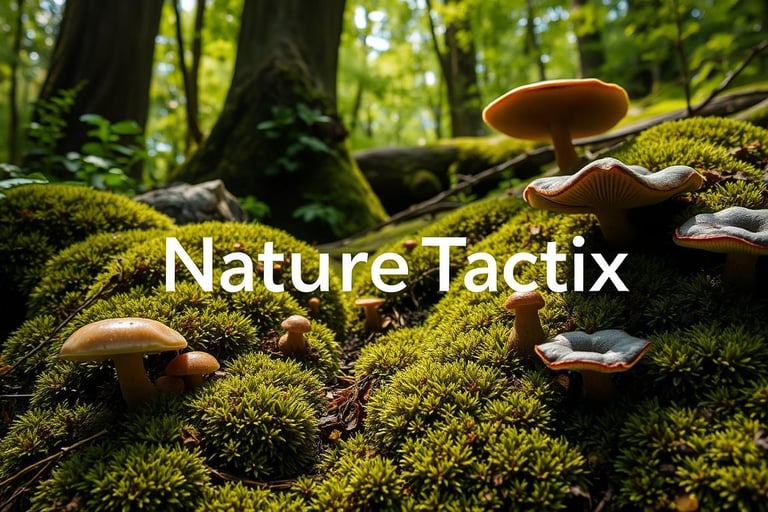


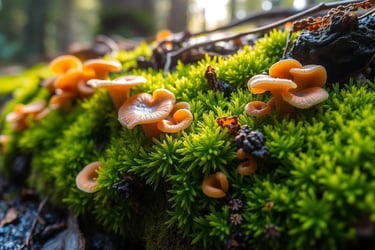



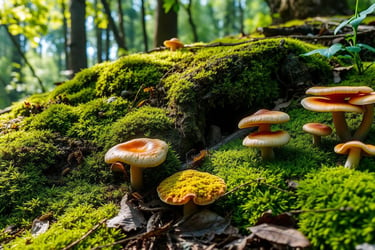


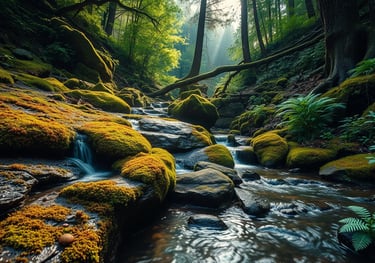
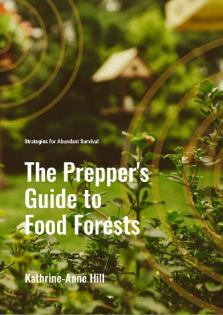

The Prepper's Guide to Food Forests: Strategies for Abundant Survival is a concise, step-by-step guide to creating a self-sustaining food forest. Ideal for preppers, it covers essential topics like design, plant selection, permaculture, companion planting, and wildlife integration. Learn how to maintain your forest, boost yields, and make it part of your survival strategy.
Highlights:
Basics of food forests and their benefits
Designing and selecting resilient plants
Creating a self-sustaining ecosystem
Using permaculture and companion planting
Maintenance, harvesting, and wildlife habitats
Food forests as part of a prepper strategy
Perfect for anyone seeking long-term food security.
Sign-Up and receive my FREE eBook The Prepper's Guide to Food Forests: Strategies for Abundant Survival !
As always, be sure to check our website for more wilderness tips and gear updates!
